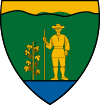Kismaros
| Kismaros | ||
|---|---|---|
| ||
 Kismaros Location of Kismaros in Hungary | ||
| Coordinates: 47°50′16″N 19°00′17″E / 47.83775°N 19.00471°E | ||
| Country | Hungary | |
| Region | Central Hungary | |
| County | Pest | |
| Subregion | Szob | |
| Rank | Village | |
| KSH code | 33738[1] | |
| Area[2] | ||
| • Total | 11.96 km2 (4.62 sq mi) | |
| Population (1 January 2009)[3] | ||
| • Total | 2,009 | |
| • Density | 170/km2 (440/sq mi) | |
| Time zone | CET (UTC+1) | |
| • Summer (DST) | CEST (UTC+2) | |
| Postal code | 2623 | |
| Area code | +36 27 | |
| Website | www.kismaros.hu | |
Kismaros (German: Kleinmarosch) is a village in Pest county, Hungary.
Location
Kismaros is located 45 kilometres north of Budapest on the eastern bank of the Danube river, just above the bend where the river changes course and flows south. The village is seated at the foot of the Börzsöny Hills on the outskirts of the Carpathians.
History
First settlers
The village's history dates back to the 18th century when Germans from the Black Forest came to settle down in the area. The name of the village first appears on the “Vályi” map from 1781. The word Maros derives from the Latin "Mures" word and means waterfront, village or fortress. By the end of 18th century the population of Kismaros reached about 200-250 persons. With the effort of all villagers the catholic church was finished in 1827. Agriculture specifically the cultivation of grapes and other fruits provided living for most residents. At the beginning of the 20th century the most spoken language is still German.
"Malenkiy Robot"
After the Second World War the Soviets took control in Hungary. Although prior to the War most residents of Kismaros claimed Hungarian ethnicity already, their German origin meant that eighty of Kismaros’ youths (aged between 16-19) were forcibly taken by the Red Army to the Soviet Union, where they used them as labourers in mines and factories.[4][5] About half of them never returned. Survivors remember it, just as the Soviets put it, "Malenkiy robot" or little labour.
Modern life
From 1976 until 1990 Kismaros had joint local government with neighbouring Verőce and was called Verőcemaros. Today's Kismaros is a busy suburban settlement of Budapest. Most of the locals work in the capital city, commuting every day by train or by car. After 1989 Kismaros became a hotspot for Budapesters trying to escape the hassles of city life; many of them settled down in the village permanently. Tourism plays important part in the village's industry, providing jobs for local businesses.
Demographics
According to the 2001 national census, Germans account for 6% of the population; over 90% are Hungarians. Kismaros has a Roman Catholic majority about 3/4 of all residents.[3] The population reached just over two thousand in 2009 and has been growing constantly in the last decade.[3]
Tourism
Börzsöny Hills' Children's Railway
Kismaros is the south terminus for one of Hungary’s oldest light railways. The railway station is in the centre of the village and has regular service throughout the year. The Börzsöny Hills' Children's Railway is a narrow gauge railway and is very popular between tourists. Every year thousands of people come to Kismaros to take a ride up to the Börzsöny Hills.[6][7]
Marus Napok
Each year end of September the locals hold the Festival “Marus Napok” to celebrate their rich German heritage. The festival's main attraction is when the people march through the village with horse-drown carriages, singing and dancing dressed in traditional clothes. Originally this was to celebrate a good vintage. There is also opportunity to taste the local cuisine and to listen to Swabian music.
Kismaros Village Museum
The museum is place for a permanent historic exhibition to give visitors some insights into the villagers everyday life. This includes typical old agricultural tools, old photos, religious relics. The exhibition covers the village life of those ethnic German settlers who arrived in the 18th century to people in present-day Kismaros.[8]
Transport Links
From the capital Budapest, Kismaros can be reached by car or public transport
By public transport
There are trains running from Budapest West railway station daytime in every 30 minutes to 1 hour. The journey time is approx. 45 minutes.
Gallery
- Diesel Locomotive resting at the Station in Kismaros
 Another Locomotive at the Station - Kismaros
Another Locomotive at the Station - Kismaros Kismaros from Visegrad
Kismaros from Visegrad
International Relations
Kismaros is twinned with:[9]
Famous Residents
- Erzsébet Viski Hungarian sprint canoer, olympic silver medalist in the K-4 500 m event (2000, 2004).
References
- ↑ Kismaros at the Hungarian Central Statistical Office (Hungarian).
- ↑ Kismaros at the Hungarian Central Statistical Office (Hungarian).
- 1 2 3 Kismaros at the Hungarian Central Statistical Office (Hungarian). 1 January 2009
- ↑ The Expulsion of the German Communities from Eastern Europe at the End of the Second World War P40, 1st Paragraph
- ↑ Kismaros rövid története, Short story of Kismaros in Hungarian
- ↑ Information about the Gauge Railway in Kismaros
- ↑ Steam train whistle
- ↑ Website for the Kismaros Village Museum
- ↑ Kismaros Testvér települései
External links
- street map (Hungarian)
